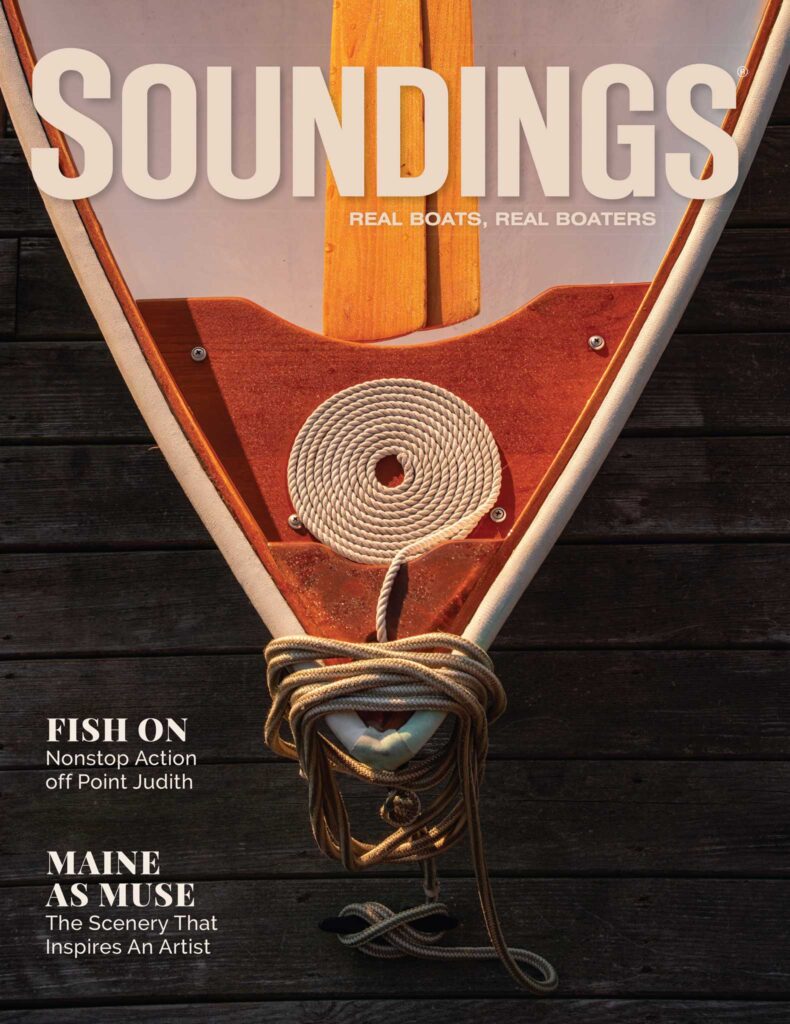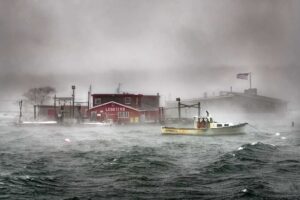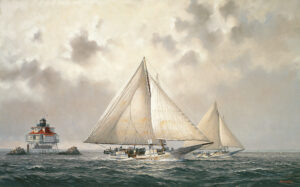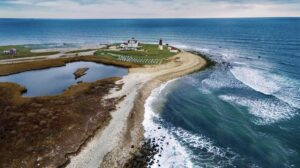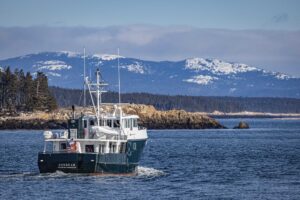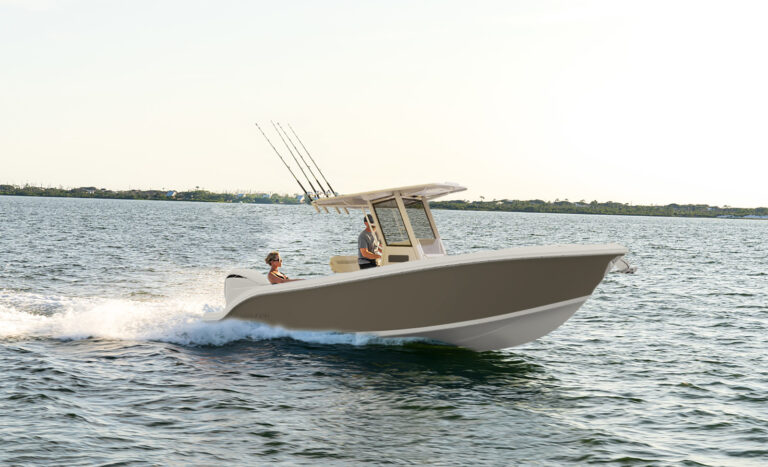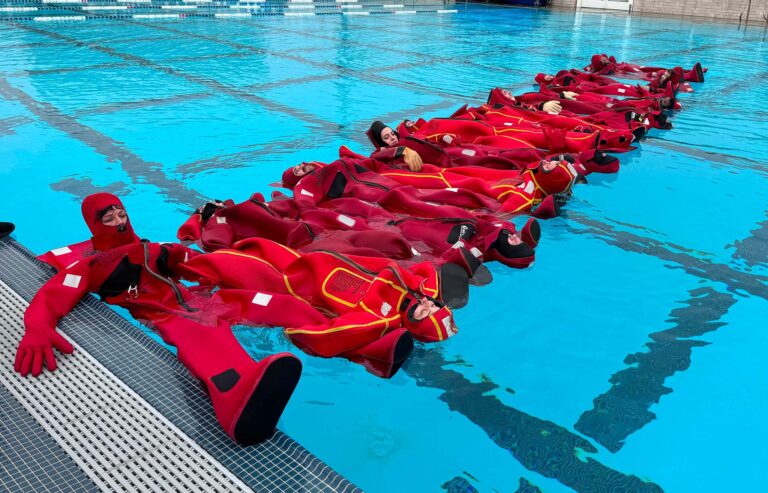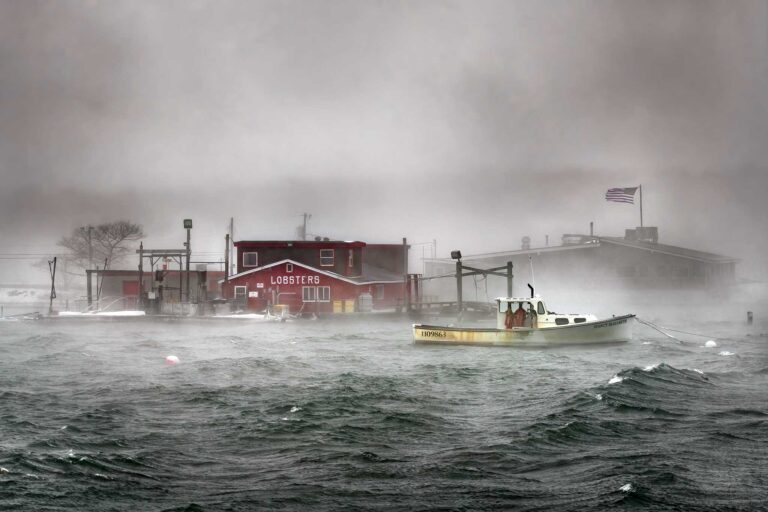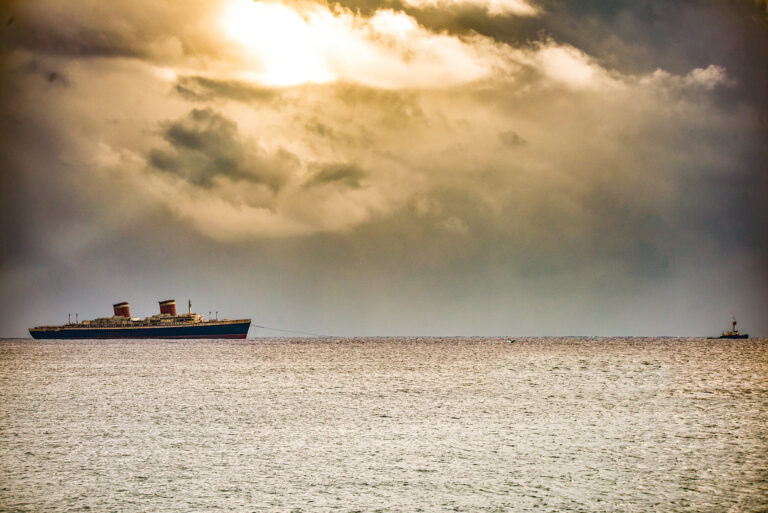Sam Chamberlin has been designing boats for Rockport Marine—a custom wooden boatbuilding and yacht restoration yard in Rockport, Maine—for 14 years, and previously spent four years building and designing boats for Brion Rieff, a builder based in Brooklin, Maine. Chamberlin’s portfolio encompasses everything from Downeast cruisers to center consoles to sailing yachts, and his job involves working closely with clients to fulfill custom design briefs. We talked with Chamberlin for some insight on his career and some of his recent projects.

When did you become interested in boat design?
I grew up in Massachusetts outside of Boston, and both of my parents’ families were in and around the water their whole lives, so I grew up with boats. I spent my summers as a kid at an island here in Maine called Isle au Haut out in Penobscot Bay. It’s very remote and there’s always a lot of back and forth to the mainland, so we always had small, open, outboard boats that were sort of commuter boats. During my high school years, we had a little production cruising fiberglass sailboat for a bit. So, I spent the better part of my life mucking about the bay and the shoreline here. From a very early age I was fascinated with boat design and had that as a career idea. I went to The Landing School of Boat Building and Design [in Arundel, Maine] as a gap year between high school and college, and then four years at Bates College [studying physics] before getting into boats full-time.
You’ve been at Rockport Marine for 14 years. What drew you to a career in wooden boat design, rather than fiberglass production designs?
It really started with wanting to live in this area of Maine and work with the people in the wooden boat community here. When I was younger, I probably saw myself going down a more standard industry path, but as I finished school and picked out where I wanted to live, this part of the world was home to me, and the people that I knew here were very much involved in the wooden boat scene. And the more I’ve worked in it, the more I’ve enjoyed it. There’s a great joy in working wood.
Were you mentored by anyone in the industry?
I never went to work for an established designer, and I was never a junior guy in an office with a big name, so I’ve found my own way without having that direct mentorship. But part of working here at Rockport, where we do as much restoration work as new builds, is that I’ve spent my whole career sort of “in” with all the great classic designers. We do a lot of work with Sparkman & Stephens designs, Herreshoff designs, William Fife designs. In a way, the hours and hours of pouring over all the designs of the older generation provided that mentorship. The other part of mentorship in my early career was working directly with a lot of great builders who had a good sense of how to design and how boats go together.

What do you strive to accomplish with the boats you design?
I always use the term good boats—honest, good design that’s not the flashiest, not the biggest, but a really good compromise. I try to focus my design work on creating a boat that works really well, is beautiful, is reasonably economical to build. It may not be the boat that’s on the cover of all the magazines and is the most expensive, but it’s a boat that does its job well and without a lot of fuss. It’s that search for the ultimate compromise that drives my design work.
What is your design process?
Like most designers now, we are working in CAD, both in 2D and 3D. But there’s a creativity that you can only get from a pencil and a drafting table, so I work pretty seamlessly between the computer screen and paper and pencil. Throughout the design process, there will be many iterations of working something in the computer, printing it out on a piece of paper, sketching on it, and then going back into the computer to integrate those ideas. I think when you see boats that were designed completely within a computer, you can tell. There’s something mechanical to them. And I think you can very often see the boats that were drawn by hand; there’s a certain humanity in them that’s hard to get otherwise.
What are you working on at the moment?
Right now, we have three designs in build that really get at who we are as designers and builders. They’re not the flashiest designs, but they’re well-built and well-grounded in the classic forms of yachts. But they’re certainly not replicas; they’re thoroughly modern designs. I think all three of them represent this part of the coast of Maine pretty well. They are three very different boats—a 20-foot center console, a 37-foot lobster yacht and a 38-foot daysailer—but they get back to a central core of who we are as designers and builders at Rockport Marine.
Tell me more about one of those designs.
The LW38 is a shoal-draft sailboat. The client has a dock space with pretty minimal water at low tide, so the standard mid-30-foot fin keel sailboat wasn’t going to work. The design brief was for a classically styled daysailer/weekender with reasonably long overhangs, a nice sheer line and more traditional joinery details in the deck and cockpit, but a boat that would be very comfortable for a couple to daysail and do some short weekend cruising. It also needs modern performance—it’s not a classic yacht or a replication of an older boat by any means. Just a good, modern boat that has a good turn of speed but is not a racing boat.
We picked a 3.5-foot draft, which was where we felt we could do a good boat in terms of getting all the volume in that we wanted for comfort and cruising while keeping it shallow enough that it could spend good amounts of time on the owner’s dock. We’ve designed it with a full fin keel. It’s a very full aspect keel, long and shallow, but it is a proper fin bolted onto the bottom of the boat, which I think will give us a better upwind performance. It also allows us to have the centerboard trunk completely within the ballast keel as opposed to coming up into the interior volume of the boat.

Your job requires you to design a good amount of both power and sail. Can you tell me about a powerboat that you enjoyed designing?
Eloise is a 26-foot length-on-deck center console with a Yamaha 300-hp outboard that I designed four or five years ago. The clients who commissioned it had a lot of experience with many yachts over the years and a lot of experience with the higher end of fit and finish. The design brief was for a really great custom yacht, but one that had a lower level of maintenance cost. They didn’t want to just buy a production fiberglass center console—they wanted a boat that was unique and that they would be really proud of owning. But it was going to be used in the Bahamas for most of its life, so they wanted a boat that would hold up to the conditions down there without having a high-level boatyard to do the annual maintenance, like they have in Maine.
So, we designed that boat without any varnish anywhere. It’s all two-part paint finishes with a fair bit of bare teak trim, for the feel of a custom Maine wooden yacht without the need for annual boatyard maintenance. And it’s on an interesting hull form. Before we designed and built that boat, we had built a couple of runabouts that were based on the Albury Brothers Runabout that originated in the Bahamas. They are built on a round-bilge hull with a moderate V that runs well through the whole speed range. It’s reasonably economical for us to build with our cold-molding methods. So, we drew on those Albury designs we had built, and then we married that to the classic Maine Downeast lobster skiffs that had been built up and down the coast here, plank-on-frame, for generations. Then we tried to apply a fit and finish that had the level of grace and elegance of a wooden yacht without the maintenance. And then the other feature of the design is the open transom, which is very much a function of the boat living in the Bahamas.
Do you have a favorite boat that you have designed?
As a designer, the real answer to the favorite question is always the next one. I love creating things. You create something and you think you nailed it, but then you want to do it again and you want to do it slightly differently. But I do think the current crop of three boats that we have in the shop right now is really nice.
What would you say to someone who is interested in becoming a yacht designer?
It’s an incredibly rewarding profession. I really enjoy the fact that my professional life and the holiday side of my life are pretty integrated. I come to work every day and muck around in boats. It can be difficult, but it is certainly an enjoyable thing to be excited to come into the office every day and take on a new challenge, especially with the new design commissions. It’s a very satisfying lifestyle.
This article was originally published in the August 2022 issue.

